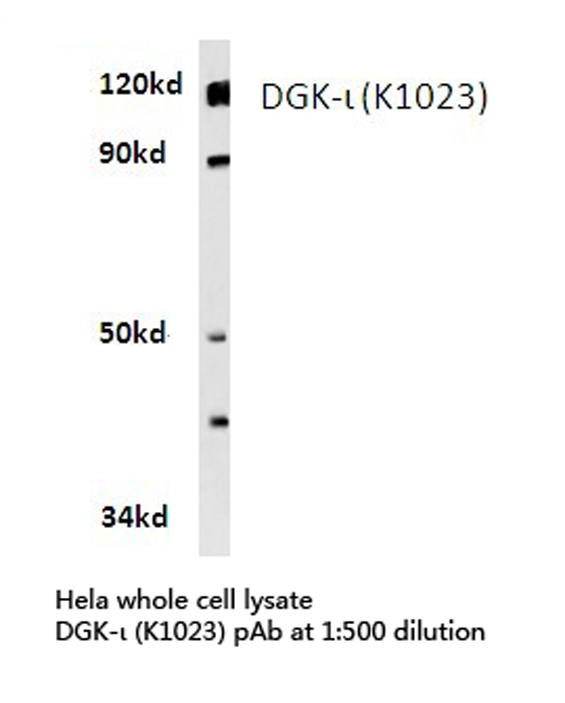DGKI Rabbit Polyclonal Antibody
Other products for "DGKI"
Specifications
| Product Data | |
| Applications | IF, IHC, WB |
| Recommended Dilution | Western blot: 1/500-1/1000. Immunohistochemistry on paraffin sections: 1/50-1/200. Immunofluorescence: 1/50-1/200. |
| Reactivities | Human, Rat |
| Host | Rabbit |
| Clonality | Polyclonal |
| Immunogen | Synthetic peptide, corresponding to amino acids 1001-1050 of Human DGK-ι. |
| Specificity | This antibody detects endogenous levels of DGK-ι protein. (region surrounding Lys1023) |
| Formulation | Phosphate buffered saline (PBS), pH 7.2. State: Aff - Purified State: Liquid purified Ig fraction Preservative: 15 mM sodium azide |
| Concentration | 1.0 mg/ml |
| Purification | Affinity-chromatography using epitope-specific immunogen and the purity is > 95% (by SDS-PAGE) |
| Predicted Protein Size | ~ 130 kDa |
| Gene Name | Homo sapiens diacylglycerol kinase iota (DGKI) |
| Database Link | |
| Background | Diacylglycerol (DAG) influences numerous cell signaling cascades by functioning as an intracellular, allosteric activator of protein kinase C (PKC), and as a potent activator of guanine nucleotide exchange factors. In order to maintain cellular homeostasis, intracellular DAG levels are tightly regulated by diacylglycerol kinases (DGKs, DAGKs), which phosphorylate DAG to phosphatidic acid, thus removing DAG. Human DGK-α (80 kDa), -β (90 kDa), and - γ (90 kDa) have calcium-binding EF-hand motifs at their N termini and are classified as type I DGKs. Human DGK-δ (130 kDa) and DGK-´(130 kDa) contain N-terminal pleckstrin homology (PH) domains and are classified as type II. Human DGK-epsilon (64 kDa) contains no identifiable regulatory domains and is classified as a type III DGK. Human DGK-Ω (104 kDa) and -iota (130 kDa) possess C-terminal ankyrin repeats and are classified as type IV DGKs. Human DGK-ˆθ (110 kDa) contains 3 cysteine-rich domains and a PH domain and is classified as a type V DGK. |
| Synonyms | Diacylglycerol kinase iota, DGKI |
| Reference Data | |
| Protein Families | Druggable Genome |
| Protein Pathways | Glycerolipid metabolism, Glycerophospholipid metabolism, Metabolic pathways, Phosphatidylinositol signaling system |
Documents
| Product Manuals |
| FAQs |
| SDS |
{0} Product Review(s)
0 Product Review(s)
Submit review
Be the first one to submit a review
Product Citations
*Delivery time may vary from web posted schedule. Occasional delays may occur due to unforeseen
complexities in the preparation of your product. International customers may expect an additional 1-2 weeks
in shipping.






























































































































































































































































 Germany
Germany
 Japan
Japan
 United Kingdom
United Kingdom
 China
China



